BMW 528I 2002 E39 Central Body Electronics ZKE Manual
Manufacturer: BMW, Model Year: 2002, Model line: 528I, Model: BMW 528I 2002 E39Pages: 80, PDF Size: 4.14 MB
Page 51 of 80
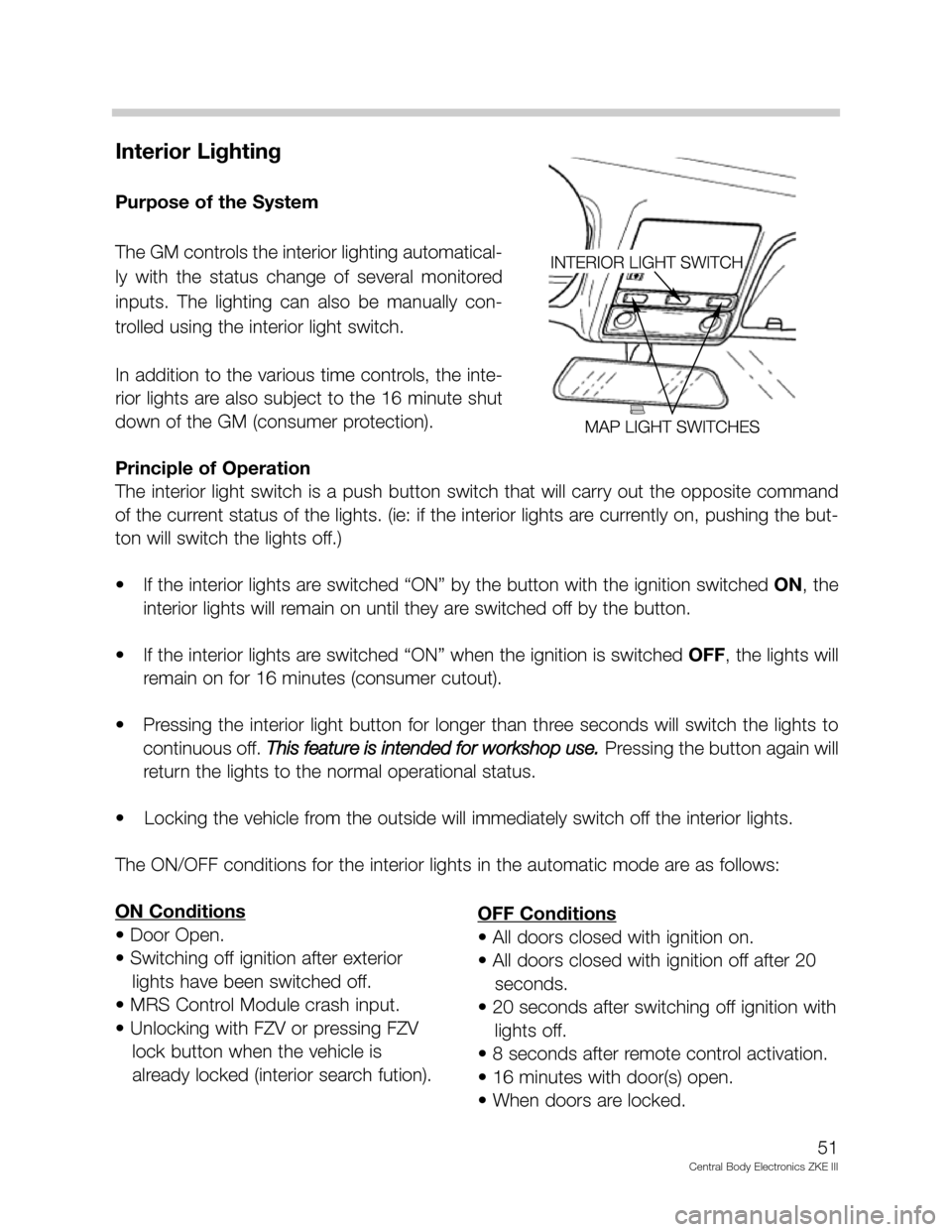
Interior Lighting
Purpose of the System
The GM controls the interior lighting automatical-
ly with the status change of several monitored
inputs. The lighting can also be manually con-
trolled using the interior light switch.
In addition to the various time controls, the inte-
rior lights are also subject to the 16 minute shut
down of the GM (consumer protection).
Principle of Operation
The interior light switch is a push button switch that will carry out the opposite command
of the current status of the lights. (ie: if the interior lights are currently on, pushing the but-
ton will switch the lights off.)
• If the interior lights are switched “ON” by the button with the ignition switched ON, the
interior lights will remain on until they are switched off by the button.
• If the interior lights are switched “ON” when the ignition is switched OFF, the lights will
remain on for 16 minutes (consumer cutout).
• Pressing the interior light button for longer than three seconds will switch the lights to
continuous off. This feature is intended for workshop use.
Pressing the button again will
return the lights to the normal operational status.
• Locking the vehicle from the outside will immediately switch off the interior lights.
The ON/OFF conditions for the interior lights in the automatic mode are as follows:
ON Conditions
• Door Open.
• Switching off ignition after exterior
lights have been switched off.
• MRS Control Module crash input.
• Unlocking with FZV or pressing FZV
lock button when the vehicle is
already locked (interior search fution).
51
Central Body Electronics ZKE III
OFF Conditions
• All doors closed with ignition on.
• All doors closed with ignition off after 20
seconds.
• 20 seconds after switching off ignition with
lights off.
• 8 seconds after remote control activation.
• 16 minutes with door(s) open.
• When doors are locked.
Page 52 of 80
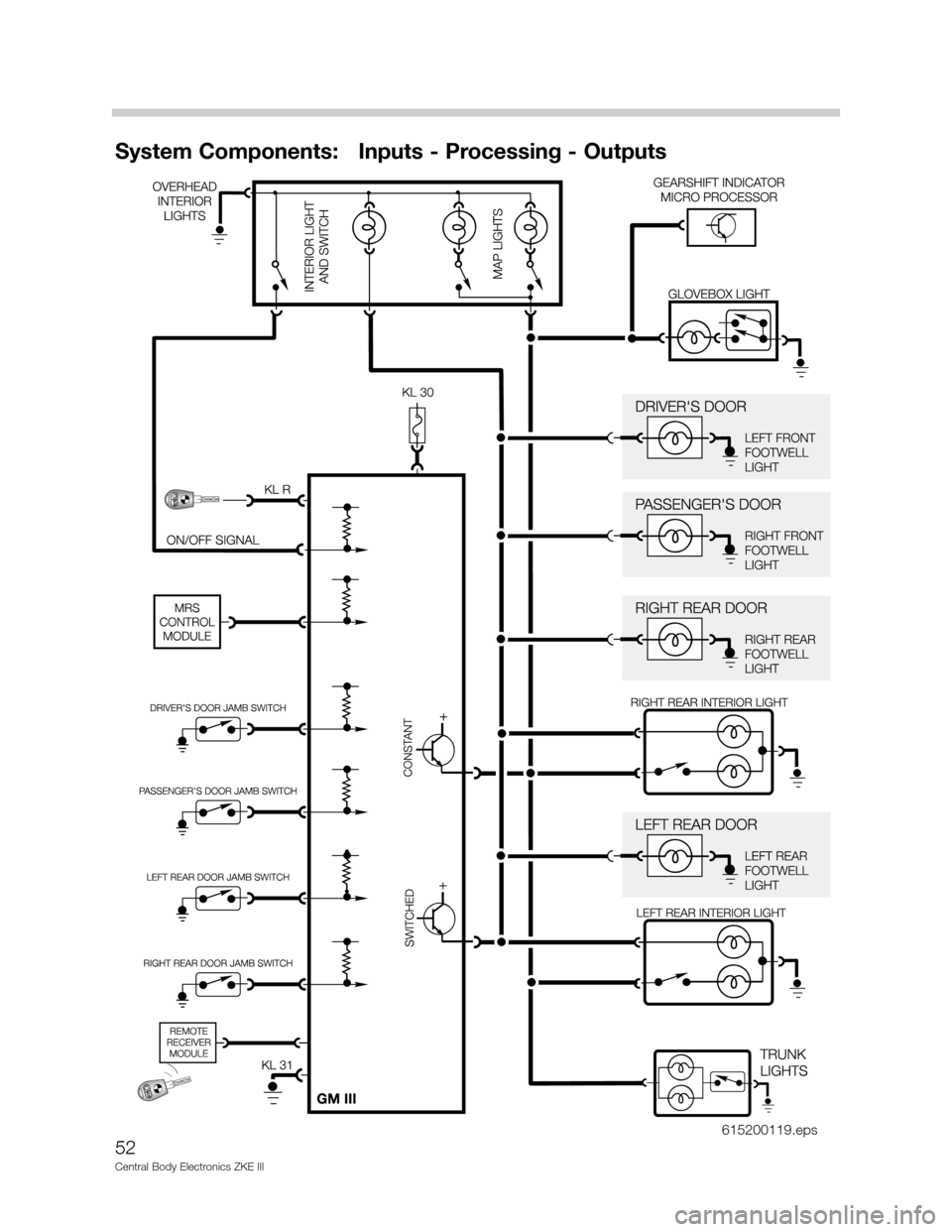
52
Central Body Electronics ZKE III
System Components: Inputs - Processing - Outputs
615200119.eps
Page 53 of 80
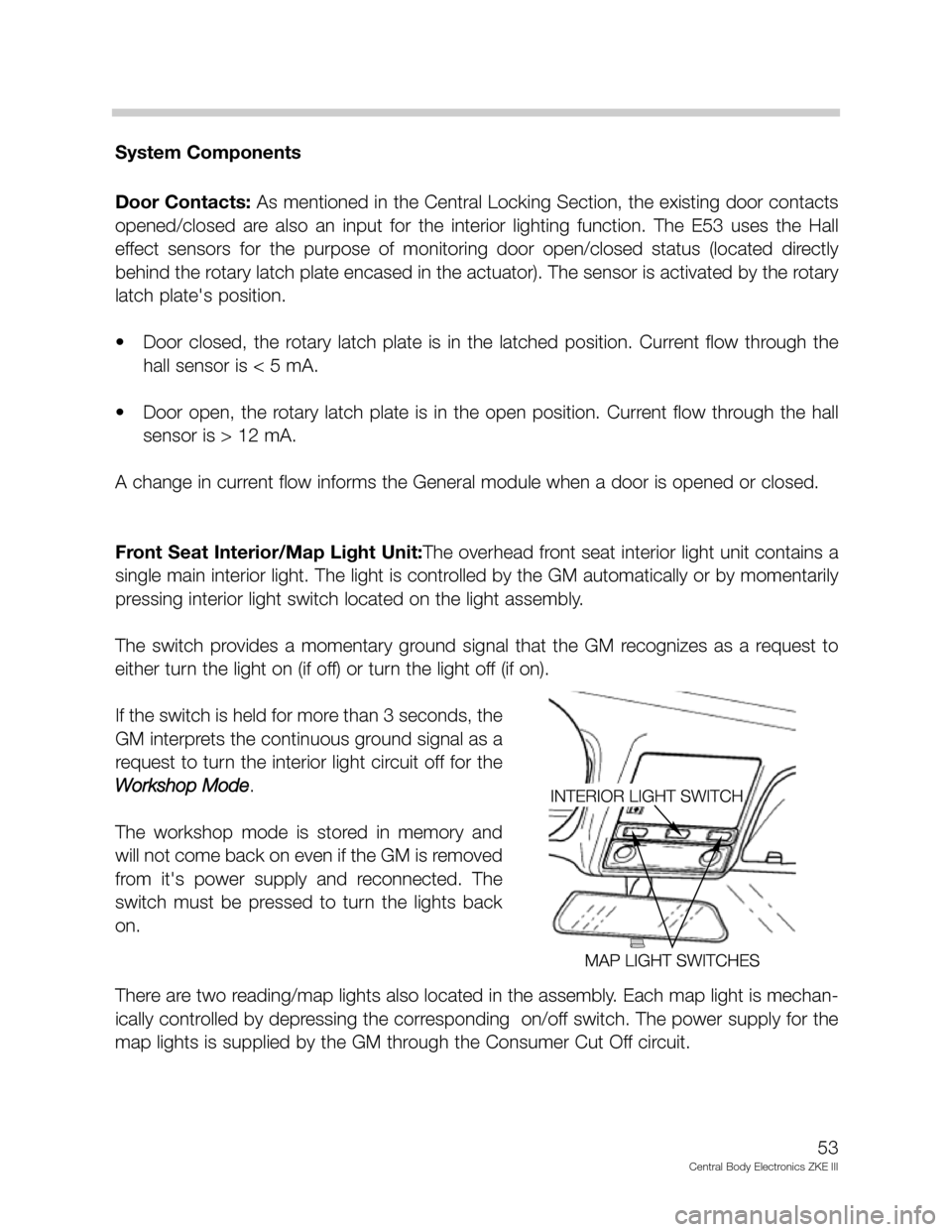
System Components
Door Contacts: As mentioned in the Central Locking Section, the existing door contacts
opened/closed are also an input for the interior lighting function. The E53 uses the Hall
effect sensors for the purpose of monitoring door open/closed status (located directly
behind the rotary latch plate encased in the actuator). The sensor is activated by the rotary
latch plate's position.
• Door closed, the rotary latch plate is in the latched position. Current flow through the
hall sensor is < 5 mA.
• Door open, the rotary latch plate is in the open position. Current flow through the hall
sensor is > 12 mA.
A change in current flow informs the General module when a door is opened or closed.
Front Seat Interior/Map Light Unit:The overhead front seat interior light unit contains a
single main interior light. The light is controlled by the GM automatically or by momentarily
pressing interior light switch located on the light assembly.
The switch provides a momentary ground signal that the GM recognizes as a request to
either turn the light on (if off) or turn the light off (if on).
If the switch is held for more than 3 seconds, the
GM interprets the continuous ground signal as a
request to turn the interior light circuit off for the
Workshop Mode
.
The workshop mode is stored in memory and
will not come back on even if the GM is removed
from it's power supply and reconnected. The
switch must be pressed to turn the lights back
on.
There are two reading/map lights also located in the assembly. Each map light is mechan-
ically controlled by depressing the corresponding on/off switch. The power supply for the
map lights is supplied by the GM through the Consumer Cut Off circuit.
53
Central Body Electronics ZKE III
Page 54 of 80
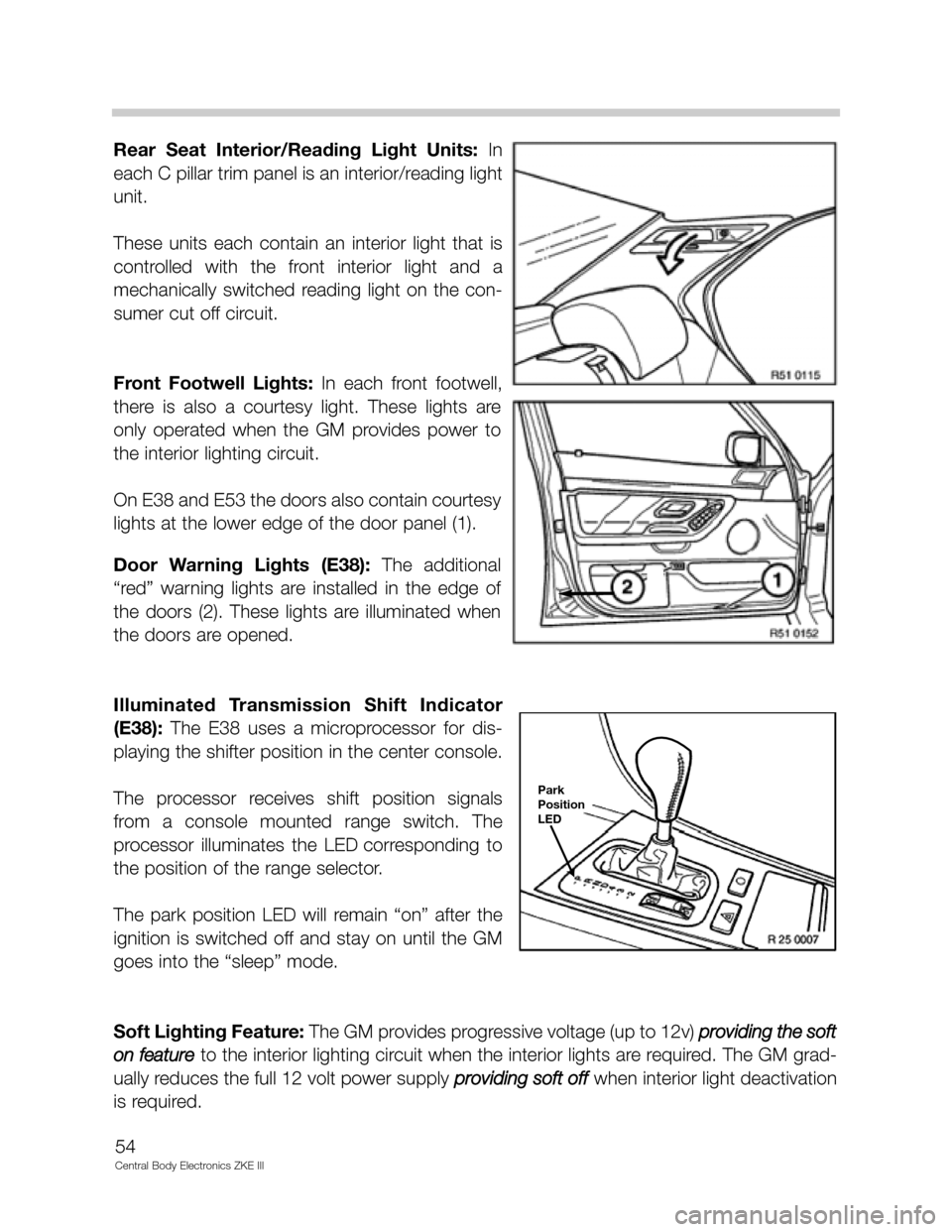
Rear Seat Interior/Reading Light Units: In
each C pillar trim panel is an interior/reading light
unit.
These units each contain an interior light that is
controlled with the front interior light and a
mechanically switched reading light on the con-
sumer cut off circuit.
Front Footwell Lights: In each front footwell,
there is also a courtesy light. These lights are
only operated when the GM provides power to
the interior lighting circuit.
On E38 and E53 the doors also contain courtesy
lights at the lower edge of the door panel (1).
Door Warning Lights (E38): The additional
“red” warning lights are installed in the edge of
the doors (2). These lights are illuminated when
the doors are opened.
Illuminated Transmission Shift Indicator
(E38): The E38 uses a microprocessor for dis-
playing the shifter position in the center console.
The processor receives shift position signals
from a console mounted range switch. The
processor illuminates the LED corresponding to
the position of the range selector.
The park position LED will remain “on” after the
ignition is switched off and stay on until the GM
goes into the “sleep” mode.
Soft Lighting Feature: The GM provides progressive voltage (up to 12v) providing the soft
on feature
to the interior lighting circuit when the interior lights are required. The GM grad-
ually reduces the full 12 volt power supply providing soft off
when interior light deactivation
is required.
54
Central Body Electronics ZKE III
Park
Position
LED
Page 55 of 80
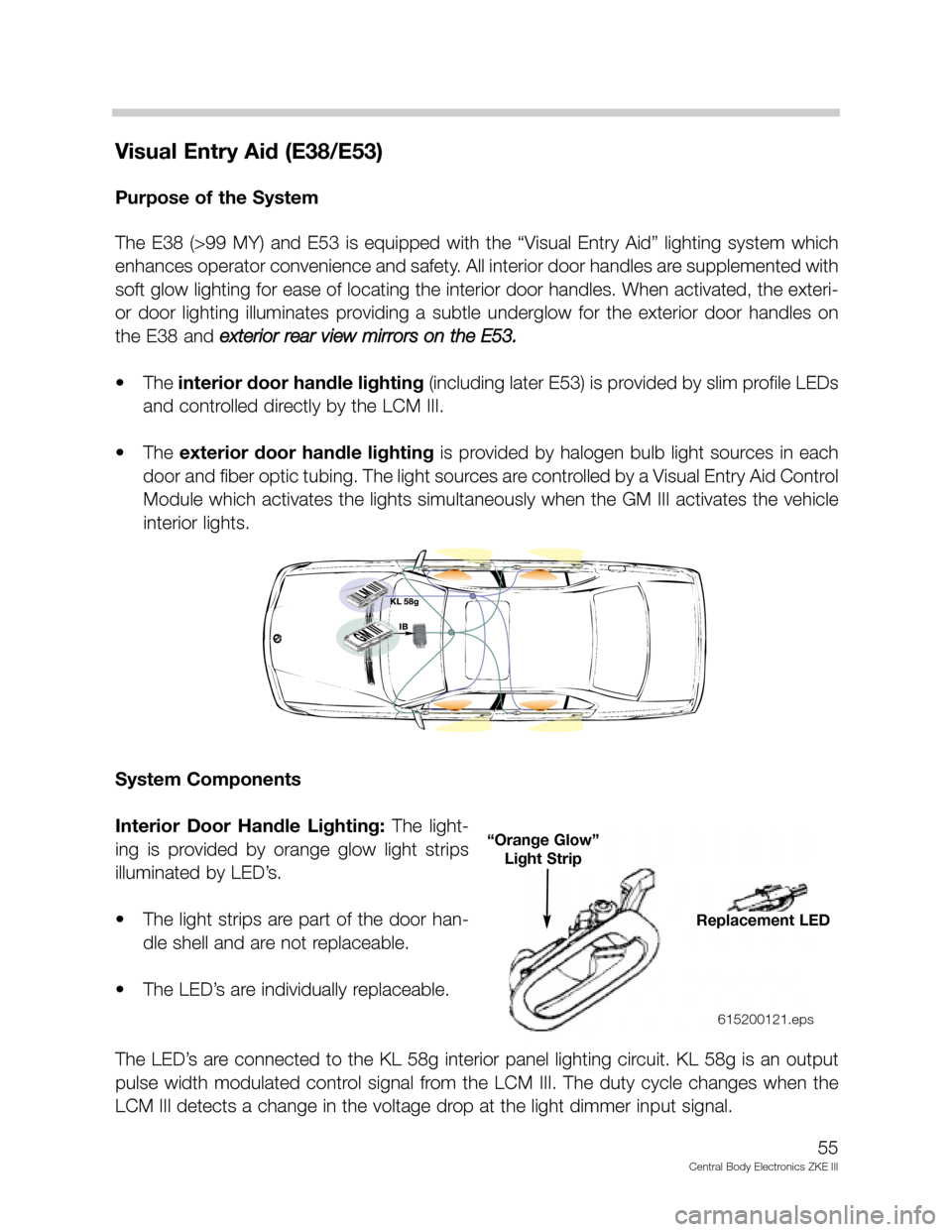
Visual Entry Aid (E38/E53)
Purpose of the System
The E38 (>99 MY) and E53 is equipped with the “Visual Entry Aid” lighting system which
enhances operator convenience and safety. All interior door handles are supplemented with
soft glow lighting for ease of locating the interior door handles. When activated, the exteri-
or door lighting illuminates providing a subtle underglow for the exterior door handles on
the E38 and exterior rear view mirrors on the E53.
• The interior door handle lighting(including later E53) is provided by slim profile LEDs
and controlled directly by the LCM III.
• The exterior door handle lightingis provided by halogen bulb light sources in each
door and fiber optic tubing. The light sources are controlled by a Visual Entry Aid Control
Module which activates the lights simultaneously when the GM III activates the vehicle
interior lights.
System Components
Interior Door Handle Lighting: The light-
ing is provided by orange glow light strips
illuminated by LED’s.
• The light strips are part of the door han-
dle shell and are not replaceable.
• The LED’s are individually replaceable.
The LED’s are connected to the KL 58g interior panel lighting circuit. KL 58g is an output
pulse width modulated control signal from the LCM III. The duty cycle changes when the
LCM III detects a change in the voltage drop at the light dimmer input signal.
55
Central Body Electronics ZKE III
Replacement LED
“Orange Glow”
Light Strip
615200121.eps
Page 56 of 80
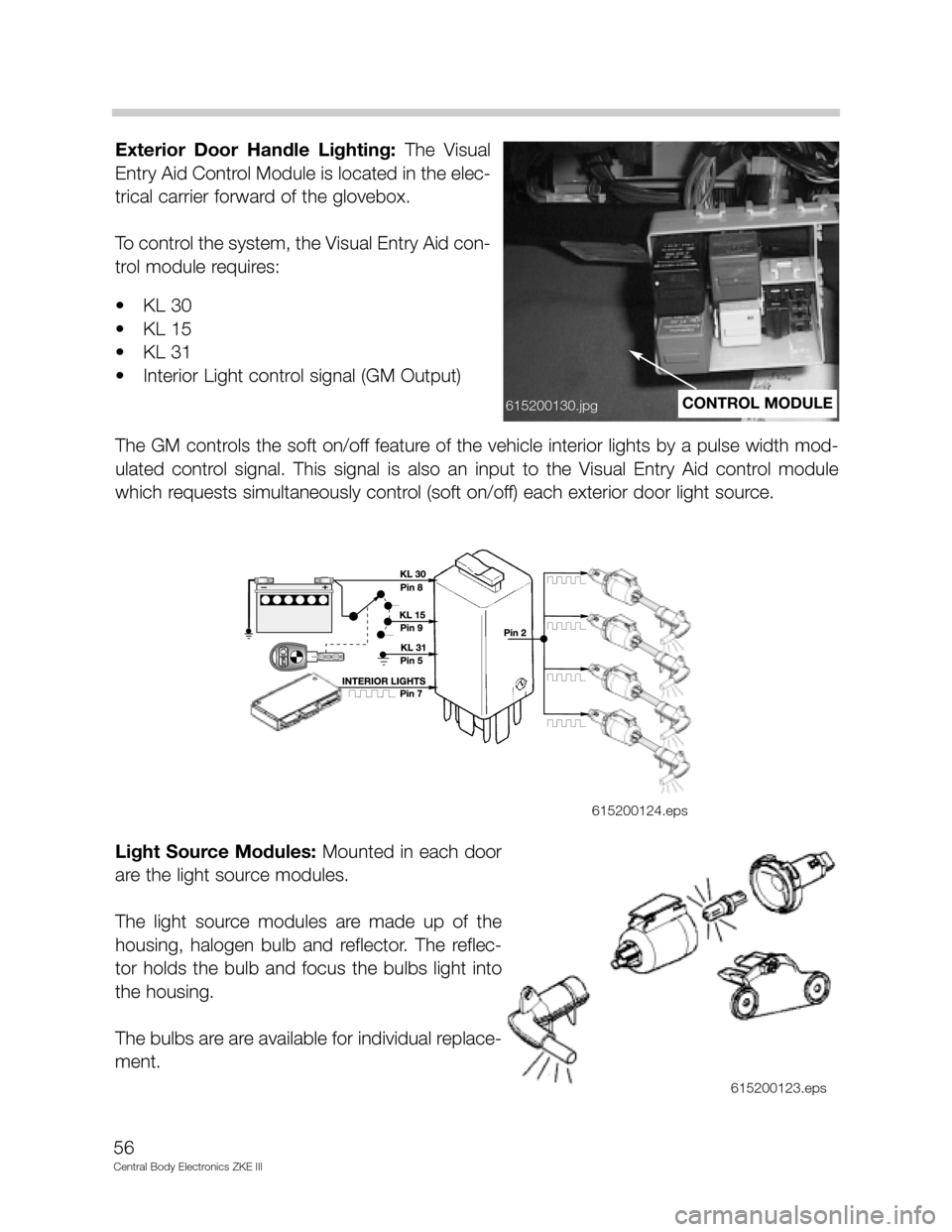
Exterior Door Handle Lighting: The Visual
Entry Aid Control Module is located in the elec-
trical carrier forward of the glovebox.
To control the system, the Visual Entry Aid con-
trol module requires:
• KL 30
• KL 15
• KL 31
• Interior Light control signal (GM Output)
The GM controls the soft on/off feature of the vehicle interior lights by a pulse width mod-
ulated control signal. This signal is also an input to the Visual Entry Aid control module
which requests simultaneously control (soft on/off) each exterior door light source.
Light Source Modules: Mounted in each door
are the light source modules.
The light source modules are made up of the
housing, halogen bulb and reflector. The reflec-
tor holds the bulb and focus the bulbs light into
the housing.
The bulbs are are available for individual replace-
ment.
56
Central Body Electronics ZKE III
CONTROL MODULE
615200123.eps 615200124.eps 615200130.jpg
Page 57 of 80
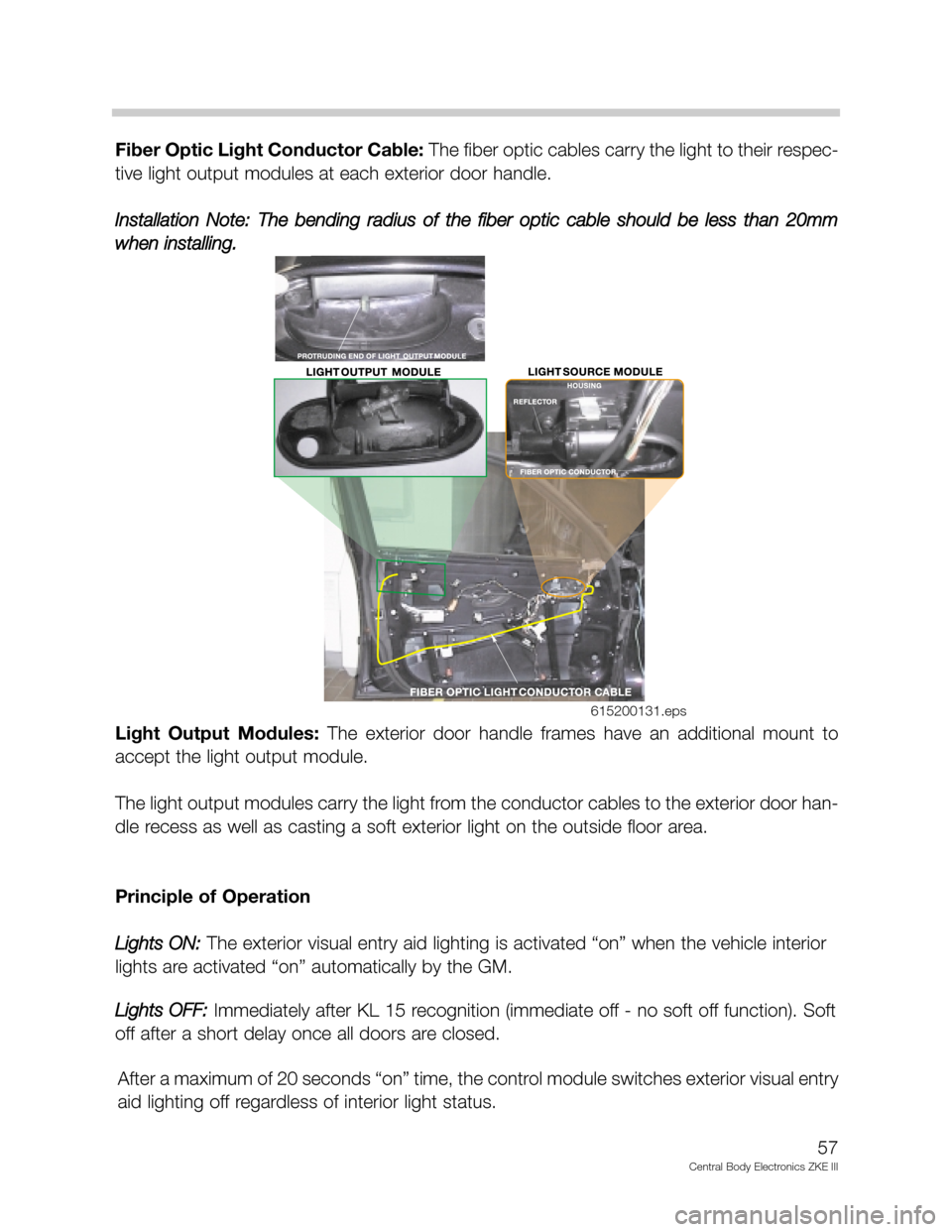
Fiber Optic Light Conductor Cable:The fiber optic cables carry the light to their respec-
tive light output modules at each exterior door handle.
Installation Note:The bending radius of the fiber optic cable should be less than 20mm
when installing.
Light Output Modules: The exterior door handle frames have an additional mount to
accept the light output module.
The light output modules carry the light from the conductor cables to the exterior door han-
dle recess as well as casting a soft exterior light on the outside floor area.
Principle of Operation
Lights ON:
The exterior visual entry aid lighting is activated “on” when the vehicle interior
lights are activated “on” automatically by the GM.
Lights OFF:
Immediately after KL 15 recognition (immediate off - no soft off function). Soft
off after a short delay once all doors are closed.
After a maximum of 20 seconds “on” time, the control module switches exterior visual entry
aid lighting off regardless of interior light status.
57
Central Body Electronics ZKE III
615200131.eps
Page 58 of 80
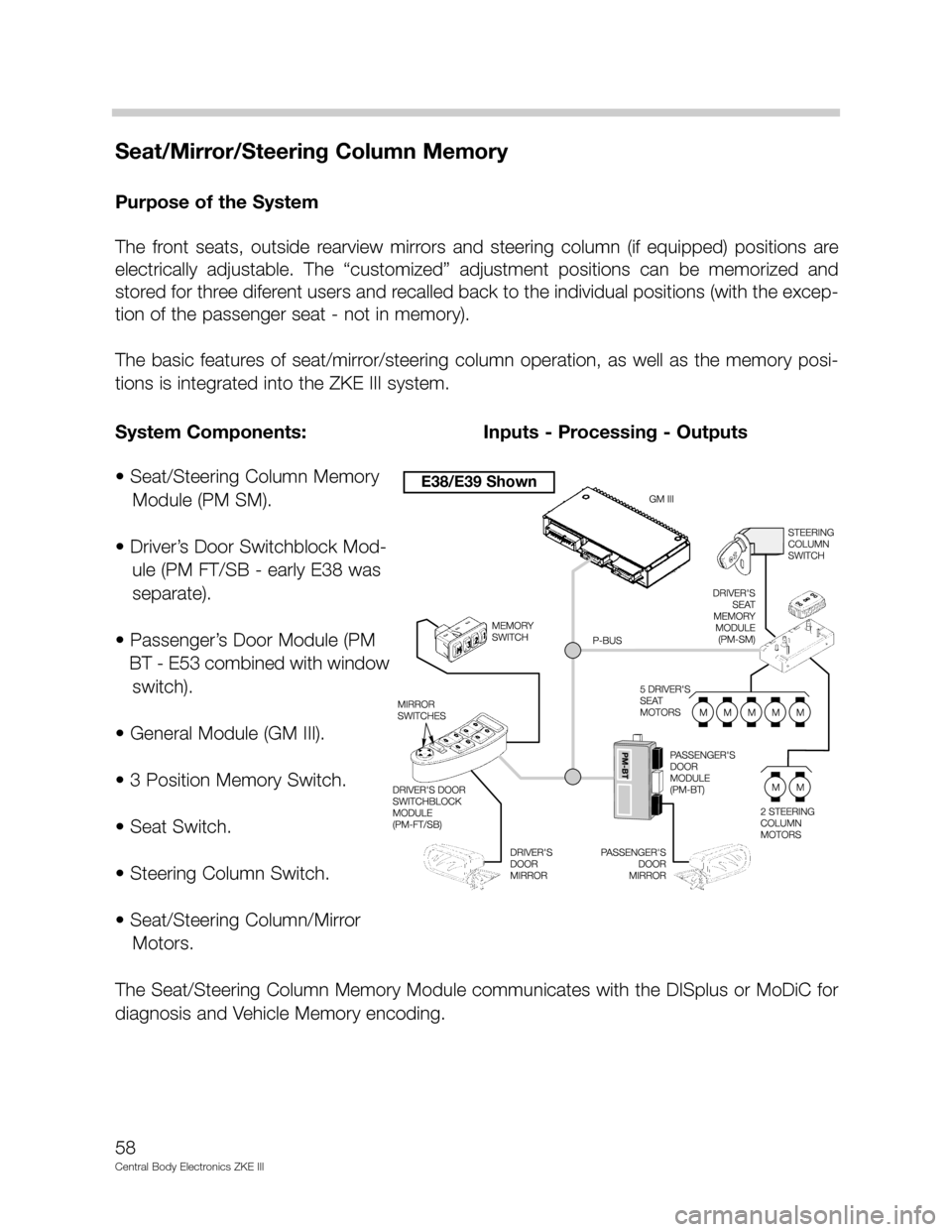
Seat/Mirror/Steering Column Memory
Purpose of the System
The front seats, outside rearview mirrors and steering column (if equipped) positions are
electrically adjustable. The “customized” adjustment positions can be memorized and
stored for three diferent users and recalled back to the individual positions (with the excep-
tion of the passenger seat - not in memory).
The basic features of seat/mirror/steering column operation, as well as the memory posi-
tions is integrated into the ZKE III system.
• Seat/Steering Column Memory
Module (PM SM).
• Driver’s Door Switchblock Mod-
ule (PM FT/SB - early E38 was
separate).
• Passenger’s Door Module (PM
BT - E53 combined with window
switch).
• General Module (GM III).
• 3 Position Memory Switch.
• Seat Switch.
• Steering Column Switch.
• Seat/Steering Column/Mirror
Motors.
The Seat/Steering Column Memory Module communicates with the DISplus or MoDiC for
diagnosis and Vehicle Memory encoding.
58
Central Body Electronics ZKE III
System Components: Inputs - Processing - Outputs
E38/E39 Shown
Page 59 of 80
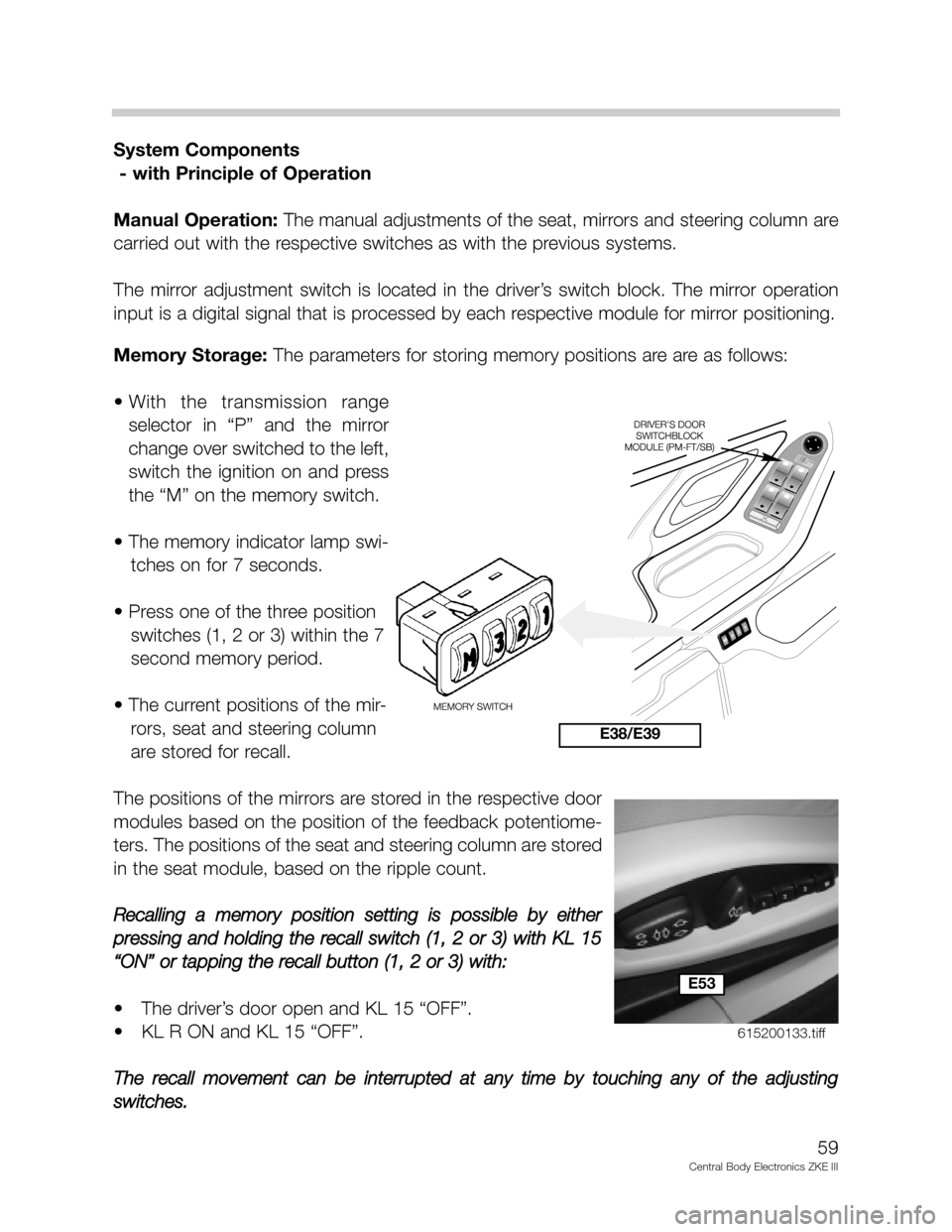
59
Central Body Electronics ZKE III
System Components
- with Principle of Operation
Manual Operation:The manual adjustments of the seat, mirrors and steering column are
carried out with the respective switches as with the previous systems.
The mirror adjustment switch is located in the driver’s switch block. The mirror operation
input is a digital signal that is processed by each respective module for mirror positioning.
Memory Storage: The parameters for storing memory positions are are as follows:
• With the transmission range
selector in “P” and the mirror
change over switched to the left,
switch the ignition on and press
the “M” on the memory switch.
• The memory indicator lamp swi-
tches on for 7 seconds.
• Press one of the three position
switches (1, 2 or 3) within the 7
second memory period.
• The current positions of the mir-
rors, seat and steering column
are stored for recall.
The positions of the mirrors are stored in the respective door
modules based on the position of the feedback potentiome-
ters. The positions of the seat and steering column are stored
in the seat module, based on the ripple count.
Recalling a memory position setting is possible by either
pressing and holding the recall switch (1, 2 or 3) with KL 15
“ON” or tapping the recall button (1, 2 or 3) with:
• The driver’s door open and KL 15 “OFF”.
• KL R ON and KL 15 “OFF”.
The recall movement can be interrupted at any time by touching any of the adjusting
switches.
E38/E39
E53
615200133.tiff
Page 60 of 80
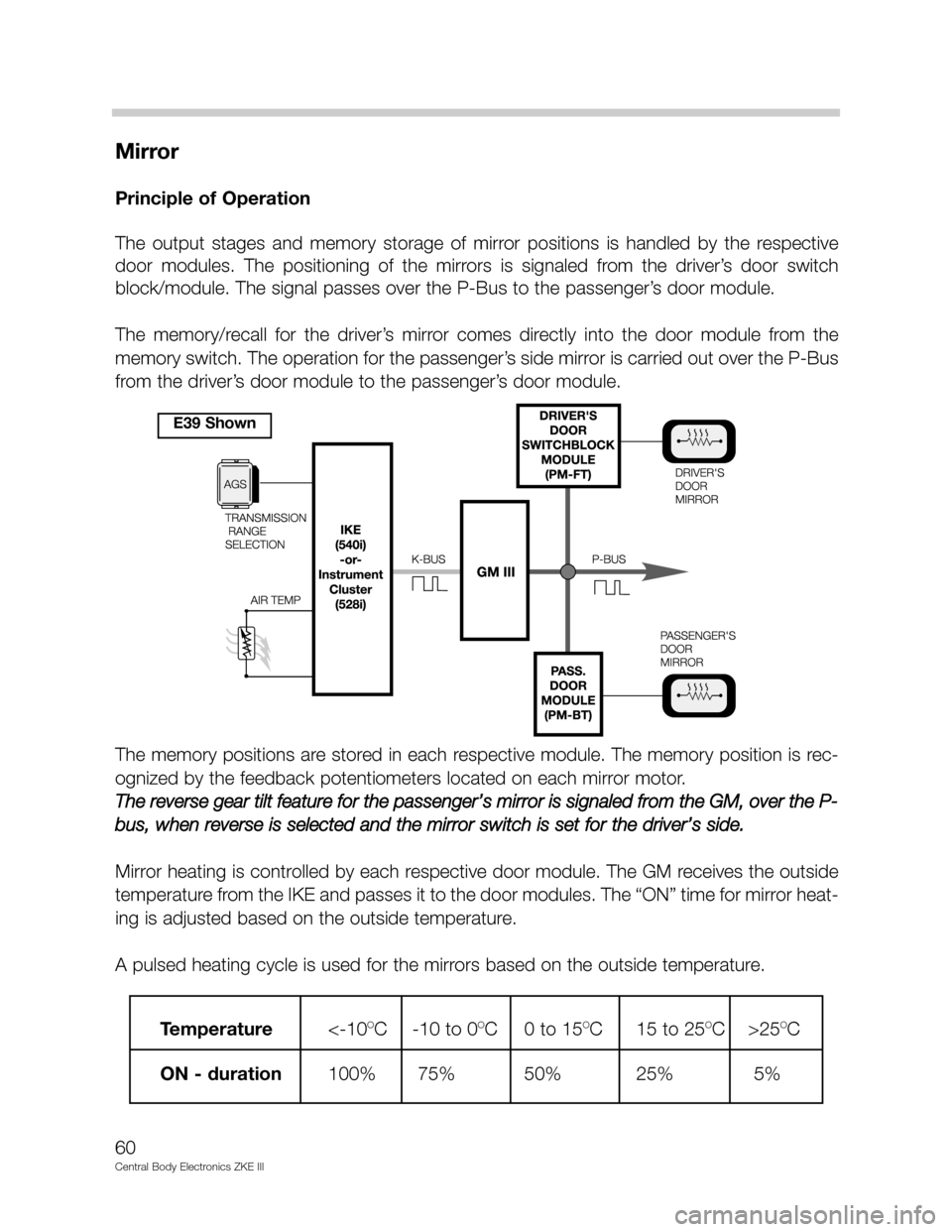
Mirror
Principle of Operation
The output stages and memory storage of mirror positions is handled by the respective
door modules. The positioning of the mirrors is signaled from the driver’s door switch
block/module. The signal passes over the P-Bus to the passenger’s door module.
The memory/recall for the driver’s mirror comes directly into the door module from the
memory switch. The operation for the passenger’s side mirror is carried out over the P-Bus
from the driver’s door module to the passenger’s door module.
The memory positions are stored in each respective module. The memory position is rec-
ognized by the feedback potentiometers located on each mirror motor.
The reverse gear tilt feature for the passenger’s mirror is signaled from the GM, over the P-
bus, when reverse is selected and the mirror switch is set for the driver’s side.
Mirror heating is controlled by each respective door module. The GM receives the outside
temperature from the IKE and passes it to the door modules. The “ON” time for mirror heat-
ing is adjusted based on the outside temperature.
A pulsed heating cycle is used for the mirrors based on the outside temperature.
60
Central Body Electronics ZKE III
Temperature<-10OC -10 to 0OC 0 to 15OC 15 to 25OC >25OC
ON - duration 100% 75% 50% 25% 5%
E39 Shown